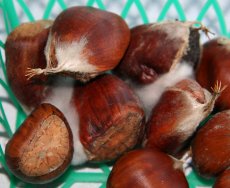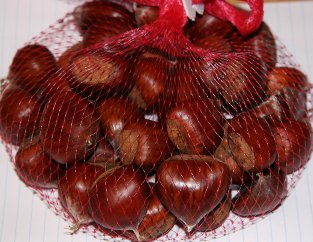| |
Post harvest handling of chestnuts affects nut quality
Chestnuts are consumed in a high moisture and low oil state. In this state
chestnuts are susceptible to going bad. Freshly fallen chestnuts are about
50% water (we can call this their wet state). When fully dried they contain
about 7 - 8 % water (this will be called their dried state). When dried,
chestnuts are stable and can be stored for months in sealed containers
(keeping the bugs out of the chestnuts). Between the wet state and the dried
state, chestnuts are susceptible to rotting. Rotting comes in the form of
spoilage from molds, yeasts, and fungus as well as freezing and thawing.
Instead of going through all the food science talk of keeping food from going
bad, lets just make a list of good handling practices for chestnuts.
1. Do not let fresch chestnuts freeze and thaw (except if you are freezing for
a purpose)
2. Never store chestnuts in a sealed plastic bag (except dried or frozen)
3. Keep chestnuts refrigerated unless drying or sweetening the chestnuts
4. If black molds have entered into the chestnut kernel, do not eat the
chestnut
5. Chestnuts can be stored in the refrigerator for 2 to 3 weeks
6. Cooked chestnuts must also be refrigerated if not consumed right away
7. Never bathe the chestnuts in plain water - this causes mold spores to be
transferred to all the chestnuts passing though the bath water - instead,
wash in clean running tap water
8. Try to purchase fresh chestnuts close to the time you want to eat them
The How to's of Harvesting and Storing Chestnuts
Burrs on the trees
Never take burrs from the chestnut trees. Taking the burrs can cause damage
to the chestnut tree by breaking branches. Also, the burrs on the tree
contain nuts that are not mature (green).
Green Burrs
Closed green burrs that fall to the ground should be left in place. In a few
days the burr will open and the chestnuts can be collected. If you do not
wait until the burrs open and the nuts are easily removed, you will end up
with a lot of "green" chestnuts. Green chestnuts have no commercial value and
will never get to the "taste good" condition a normal ripe chestnut will
achieve.
Opening Burrs
Never open burrs on the ground with the soles of your feet by stomping hard
on the burrs. This will crush the chestnuts inside of the burrs. The best
method is to roll the burr under the foot applying pressure until the burr
either falls apart or the nuts come out. If you feel like you have to apply
too much pressure, then just leave the burr for a few more days. In a few days
the burr will loose its ability to hold together and the nuts come out.
Washing Chestnuts
Never wash chestnuts in a bath except for possibly a hot bath (60oC for 2
minutes). A water bath transfers mold and fungus spores from the chestnuts
to the bath water and then to all the chestnuts that pass through the bath.
Even a hot water bath should be reserved as a last resort (molds already
showing). Only wash chestnuts with fresh domestic water from wells or treated
water supply (city water). If you suspect your chestnuts may have chestnut
weavels in your chestnuts, the chestnuts can be treated with a hot water bath.
The bath must be 120 degrees F (49c) and the nuts must be soaked for 20
minutes. The bath temperature is very important, much cooler than 120 and the
larva are not destroyed, much hotter and the chestnuts start to cook. When
done soaking the nuts must be air dried before being placed in storage.
Storing Chestnuts
Chestnuts must be refrigerated to keep from going bad if the chestnuts are
not planned to be used in the next 2-3 days. Never store chestnuts in a
sealed plastic bag/container because they will go bad, either in taste or rot.
Chestnuts will dry out if left out on a tray where the air circulates.
Once dried, the chestnuts will store for several months either in a sealed
dry storage container (something like a cookie jar) or in the freezer.
Chestnuts can be frozen raw in the freezer. In the raw frozen condition
chestnuts will store for about 3-4 months. If you freeze raw chestnuts, the
texture of the nut will change. For some people this is unacceptable. For
others they do not mind the small change in texture. Its up to you find what
works best for you if you want to store the chestnuts for more than a week or
two in the refrigerator.
Return to Chestnut Guide Index
|
|
|
|
Examples
Chestnuts Piled Up

If chestnuts are placed in open air piled up, they will grow molds in just a
few days.

Chestnuts have to be stored in open sacks so they don't go bad. These chestnuts
are looking good. Because they have never been washed or sanitized, these
chestnuts will grow molds in just a few days if left out in open air. Always
store unused chestnuts in the refrigerator.
|
|


